Want to know how to get rid of weeds in your veggie garden without harming your plants or your health? Try these natural methods.
You’ve planned. You’ve toiled and sweated and planted.
You’ve waited patiently for all your hard work to transpire into the beautiful, productive vegetable garden of your dreams.
But then, after spring rains come and the garden finally starts warming up…
Here come the weeds!
How do weeds affect plants?
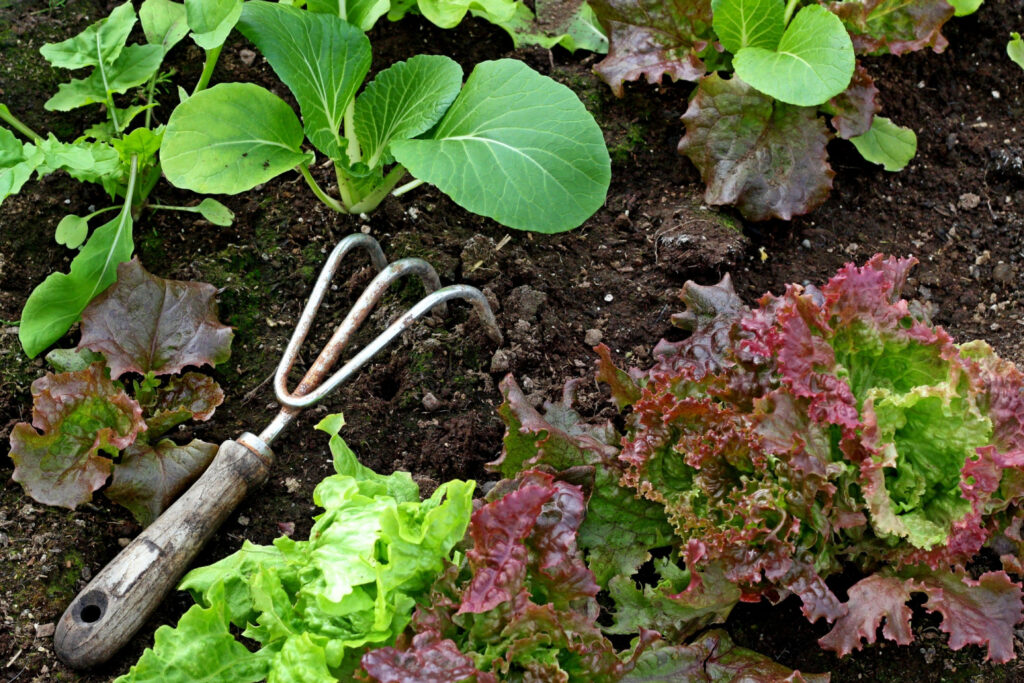
Unwelcome, exhausting and unappealing; weeds are the bane of every gardener’s existence.
Weeds are not only unsightly, they can:
- Compete with garden plants for nutrients (or even choke them out)
- Take up valuable garden space
- Invite garden pests and harbor plant diseases (as if they need more help!)
- Block sunlight
And let’s not forget, when they are left to take off and go to seed, they create…more weeds!
I’ve driven by many gardens in mid-summer where the owners have given up and the weeds have taken over, and it is a sad sight!
Alas, it doesn’t have to be this way.
How to get rid of weeds in the vegetable garden- naturally
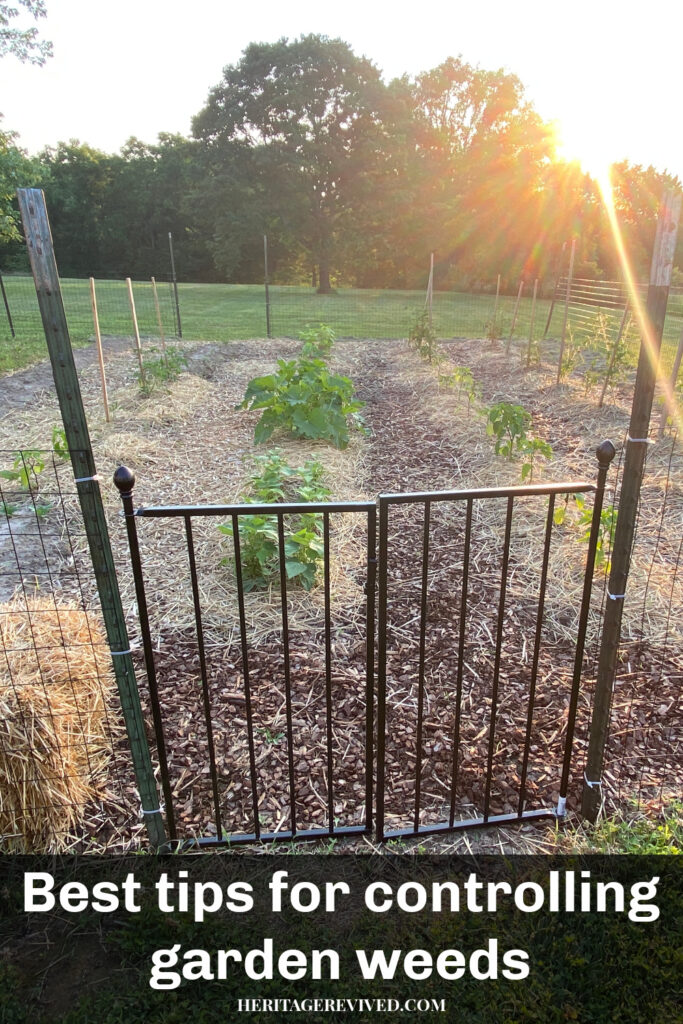
After a lot of trial and error and research over the years, these are the best ideas I’ve found and used in my vegetable garden.
Here are our top 5 best natural ways to get rid of weeds, and stopping them before they even start!
This site contains affiliate links to products. As an Amazon associate, I earn from qualifying purchases. Please read my disclosure for more info.
1| Try a no-till method
Of course, if you’ve already tilled up your garden spot this year, this won’t be helpful! But consider going to a no-till method next time around.
It may sound counterintuitive, but the truth is you’ll always have more weeds in a traditional, in-ground garden that’s been tilled.
Why? Because, for one, there is a lot of bare ground for errant seeds to find a home within.
Second, when you till, you’re really just pushing the existing weeds/grass deeper underground, and eventually those seeds & weeds will come up.
And every time you continue to till throughout the season, the ground is disturbed and the cycle repeats.
Just by NOT tilling your garden area, you’ll have far fewer weeds to deal with over time, and an easier-to-manage garden.
4 types of no-till gardens to try:
- Container gardens
- Raised beds
- Lasagna gardens
- Raised row garden (my current favorite)
- No dig / No till
There are numerous benefits to a non-traditional garden plan, but in my opinion, having a garden that is optimized for less weeding is the biggest perk!
The raised row garden has worked well for us the last few years, and I don’t plan on ever going back to using a tiller again.
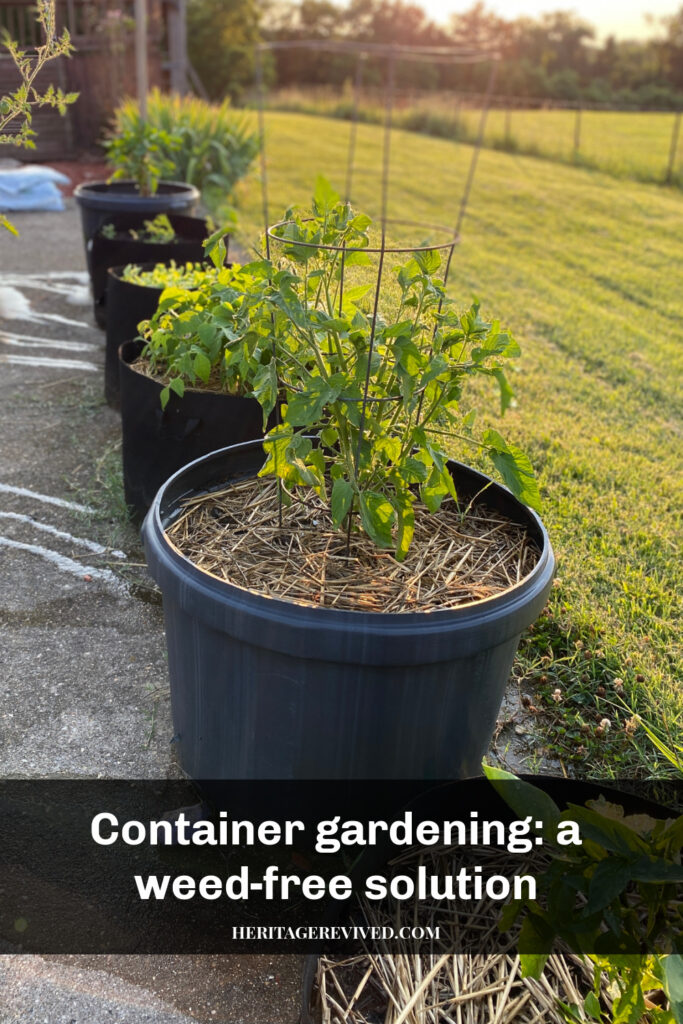
2| Mulch, mulch and more mulch
Mulch not only helps to retain moisture in the garden, it also can prevent weeds pretty effectively (especially after several seasons of mulching).
It wasn’t until I understood the benefits of mulch that I started using it generously in my garden – with amazing results.
I’ve found that the first year working with a new garden spot is the hardest and usually will still require weeding, despite layers of mulch.
But after the first year of diligence, the weeds are much fewer and far between.
Safe mulches in the garden
Some store-bought and naturally-occurring materials are better than others for mulching a vegetable garden.
Even if the mulch you’re using is just for walking rows and won’t be placed directly up against your garden plants, you want to choose materials that won’t leach chemicals or undesirable contaminants anywhere in the garden area.
Newspaper:
Newspaper is non-toxic and safe to use in veggie gardens. Today, most ink is made from soy.
We use several layers of newspaper in my walking rows (not around the plants directly — they get too soggy and weird), with a few inches of hardwood mulch on top.
Pine needles (pine straw):
If you have pine needles readily available in your area (I don’t unfortunately), they can make a nice mulch that’s lightweight and easy to spread.
It can be somewhat less expensive than wood mulch and a better choice to place directly around garden plants.
Hardwood mulch (wood chips)
Chipped wood is another great choice for walking rows.
Look for the larger-chunked hardwood mulch that isn’t dyed and that won’t break down as quickly.
Grass clippings
This is my favorite garden mulch because it’s free! It’s easiest to gather if you have a bagger on your mower, of course.
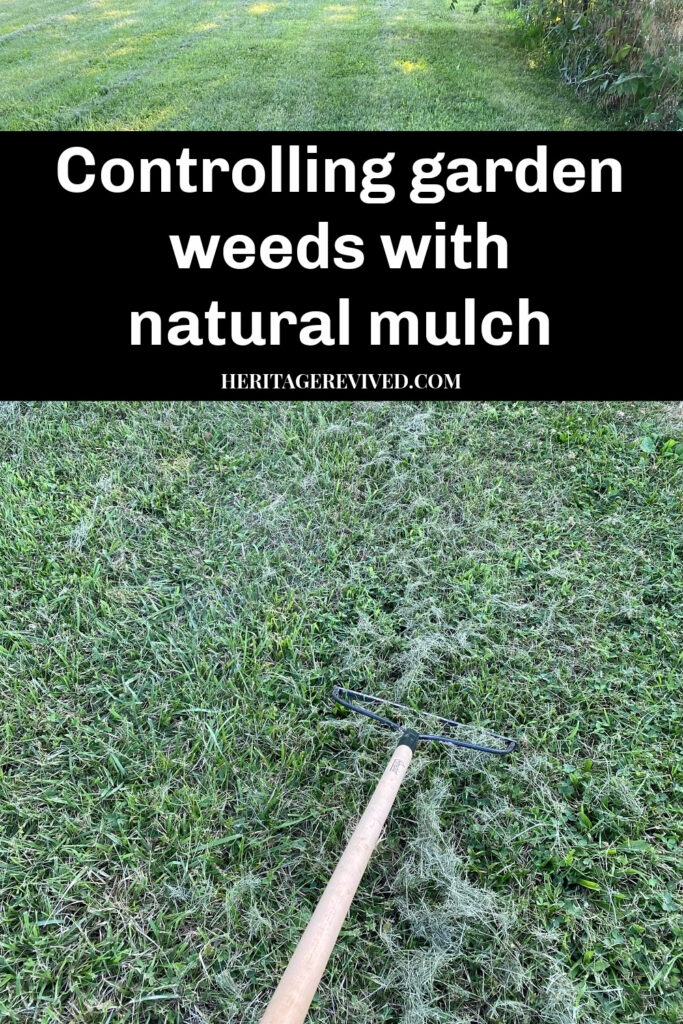
For us, we rake up what we need the old-fashioned way.
Give the kids a rake and let them pitch in on the fun! 😉
In the spring when it rains a lot, it doesn’t take long to fill up a wagon or wheelbarrow with a good supply of dried grass to use around plants OR in walking paths.
Like newspaper, you’ll need a fairly thick layer for effective weed prevention.
Leaves
Shredded leaves can work well around plants, and whole leaves work better in walking paths as they take longer to break down.
If you don’t have a ton of trees in your yard, ask your friends or neighbors; they may be happy to give away their free “mulch”!
Straw
Straw bales can be purchased from many garden and farm centers.
I use straw in my growing rows, directly around vegetables and it works well for preventing weeds and retaining moisture.
I have found that it’s almost impossible to find straw in my area that doesn’t have at least some grass seeds.
However, those tiny grass seedlings are easy to pluck with their shallow roots, and I consider it a trade-off for the larger, more stubborn weeds they prevent.
Just be sure not to put straw down until your seedlings have taken off, otherwise it can prevent those tiny seeds from sprouting.
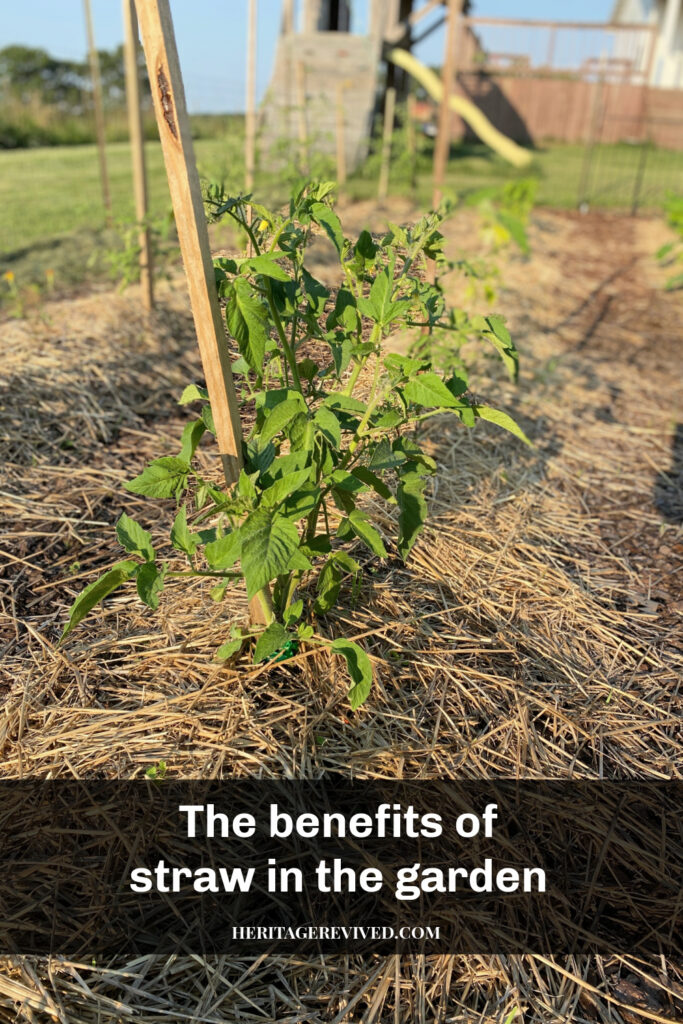
Cardboard
Cardboard isn’t something I utilized until more recently in my garden. After learning more about no-dig gardening, I found out how useful cardboard can be.
If weeds are coming through your existing mulching methods, try raking back some of the mulch, and adding a piece of cardboard over the weeds. Then top with the existing mulch, plus some more.
The idea is that by NOT pulling those weeds up, you’re disturbing the soil less, bringing less weed seeds to the surface, and keeping soil from becoming exposed where new weeds can embed.
3| Break out the Vinegar
In the vegetable garden, vinegar is safe, non-toxic and effective on weeds.
I have read for years that you need a high concentration of vinegar to kill weeds, and this is true for huge, established, or stubborn weeds (in fence rows, for example.)
But for most vegetable garden weeds, plain old white distilled vinegar in the grocery aisle works great.
In fact, this season I’ve experimented with both a 20% vinegar and regular distilled vinegar (which is usually around 5%), and I did not notice a huge difference in effectiveness.
My advice: save your money and try the distilled version first!
How to use vinegar as a weed killer in the garden:
- Add straight vinegar to a 1-gallon garden sprayer and spray in walking rows, away from plants/leaves and especially young seedlings. (Hand pick any weeds within several inches around base of plants instead.)
- Be sure to spray in the early morning or on a sunny day; the sun will help the process along
- You can add a few tablespoons of (unscented) castile soap to your vinegar if desired, to help it to bind to the weeds.
I routinely use vinegar around the fence line of my garden to make it easy to mow around.
4| Try Organic Preen
Preen is a brand of weed preventer that comes in several varieties for different purposes.
The only kind of Preen I have found that is safe to use in vegetable gardens is the this version, which is made entirely from corn gluten. (Epsoma also carries a similar version).
It almost sounds too simple to be true- but it does work well!
You just sprinkle a layer of the granules on the ground and either water it in, or sprinkle it just before it rains.
I have only used Preen in the walking rows, just as an added precaution. But this organic version appears to be completely safe for using around vegetable plants as well.
You want to be sure your plants are well-established; don’t sprinkle around seeds you’ve just planted or it may prevent them from germinating.
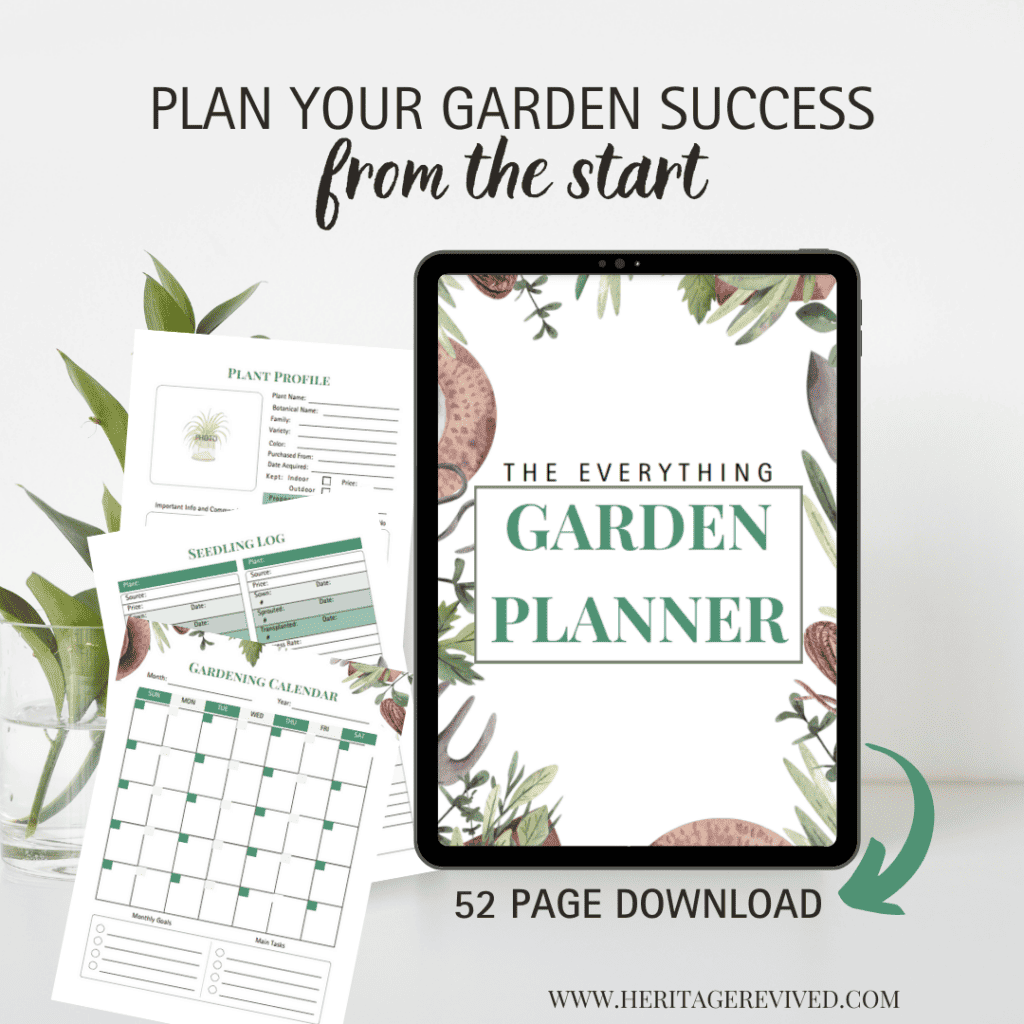
5| Decrease plant spacing
I have often found that the “recommended” spacing for plants is a little more than what is actually necessary for optimal growth.
It’s true that there is a balance to strike between “a little closer” and overcrowding.
Even planting your tomato plants a few inches closer together can help to cut down on the weeds, though.
The less available dirt for weeds to grow – the better.
6 | Use companion planting
In addition to planting your veggies closer together, you can use companion plants such as herbs to reduce the bare ground and make better use of it between plants.
I plant basil between my tomato plants, which is supposed to help deepen their flavor. It also leaves less room for weeds to grow.
The same concept applies if you plant Pole beans near the base of your corn. They can climb up the corn, but also prevent unwanted seeds from finding a home in the dirt around your corn crop.
Carrots Love Tomatoes is a helpful book for learning more about the benefits of companion planting.

7| Commit 10-15 minutes a day
You can manage weeds in the vegetable garden with the above tips, but there will always be weeds that pop up, even if minor ones.
If you want to have a successful garden at all, you need at least 10 minutes a day of walking through your garden and hand-pulling any weeds that sprout up (or covering them with cardboard and mulch).
Daily maintenance is the most organic and cheapest way to get rid of weeds, after all!
This is my favorite tool for stubborn weeds like dandelions.
Spending 10 minutes a day to stroll through the garden is critical for not just weeding, but inspecting plants for disease and harmful insects.
Controlling garden weeds for good
Truly, anywhere there’s dirt, water and sunlight, you’re going to see some weeds from time to time.
The best way to keep them from becoming a headache is to stop them before they get out of hand.
With careful garden planning, mulching, and occasional use of common household products, it’s possible to prevent and get rid of weeds in the vegetable garden without back-breaking work.
And it’s possible to use natural ways to get rid of weeds, instead of resorting to chemicals that can cause more problems than they solve.
Again, if you’re tending a brand-new garden plot, don’t let weeds get the best of you; it gets easier year after year, once you employ these methods.
As you see, you can maintain a natural garden and have a beautiful space with minimal weeding required; it just takes a little time and diligence!
Read next:
Beginner Gardening Mistakes (avoid these)